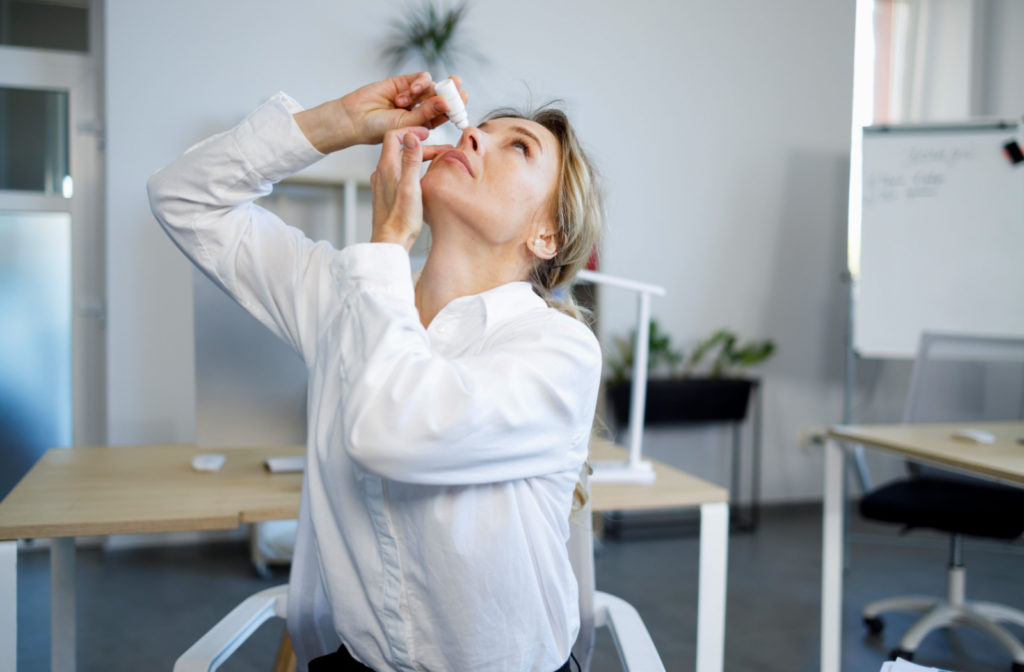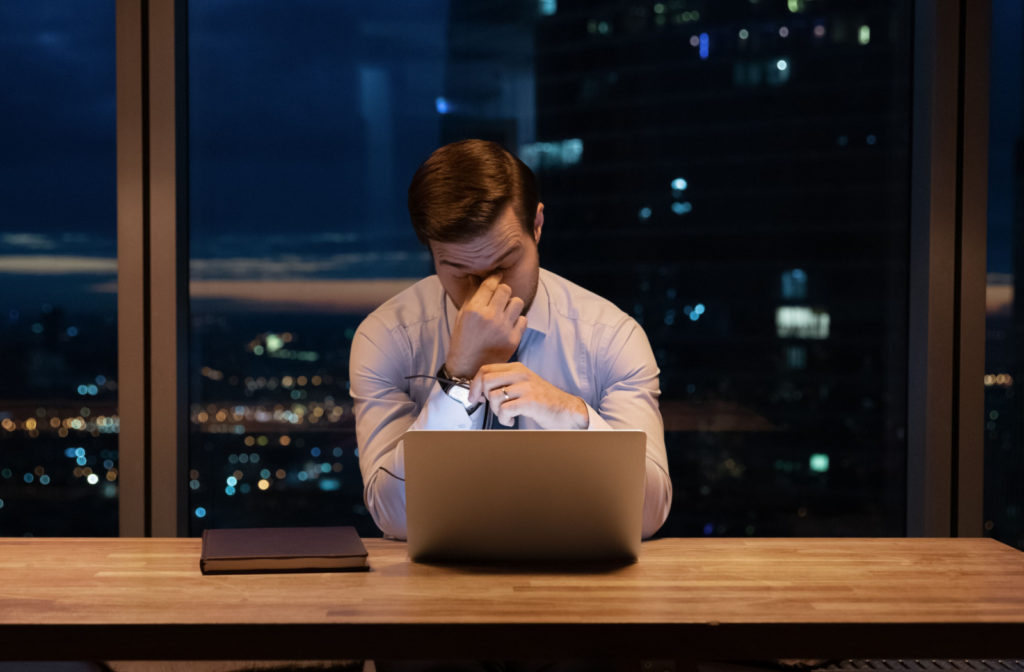Every day, we are surrounded by screens. Smartphones, televisions, computers, tablets, and gaming devices are present—and often so is digital eye strain. With many Canadians spending 2 hours per day or more on digital devices, uncomfortable and irritating eye strain symptoms are becoming more prevalent.
While technology isn’t the only cause of eye strain, it is a major contributing factor for many people.
While the duration of eye strain symptoms differs for everyone, it can go away within minutes to hours of an individual ceasing high-focus activities.
Specific treatments and strategies can also help reduce the effects of eye strain.
Regular eye exams are one of the most important steps to find relief from chronic eye strain.
What Is Eye Strain?
Digital eye strain is a combination of eye symptoms caused by prolonged screen use. When caused by excessive screen time, it is also known as computer vision syndrome. Eye strain can cause your eyes to become sore and tired from focusing for a lengthy period.
When using a computer or engaging in any high-concentration activity, your eyes must focus and refocus, which can drain them physically, especially if done for extended periods of time without rest. While using electronics is a common cause of eye strain, other activities such as reading and driving can also induce eye strain symptoms, such as:
- Headaches
- Eye pain
- Watery eyes
- Back or neck aches
- Fatigued eyes
- Sensitivity to light
What Causes Digital Eye Strain?
Eye strain is frequently caused by prolonged or unrestrained use of focusing muscles during tasks that place a greater demand on our eyesight. It is normal to spend a lot of time each day engaged in close-up tasks, yet this can be rather irritating for our eyes.
Possible causes of eye strain include our posture when engaged in high-focus activities such as using digital devices or reading, forgetting to blink as regularly as necessary, and holding digital devices or books too far or too close to our eyes.
Specific activities and other circumstances that can induce eye strain include:
- Long periods of reading and writing
- Driving with a digital screen
- Reading in low light

How to Prevent Eye Strain
In addition to treatment and support from your eye doctor, some simple strategies for finding relief from eye strain can be included in your daily routine.
Monitor Your Screen Time
Too much screen time can significantly affect your sleep, in addition to causing eye strain. Blue light can disrupt the brain’s sleep pattern when used close to bedtime. The brain can alter the body’s sleep cycle because it perceives the screen light as daylight.
Reducing your screen time is essential in helping to find relief from eye strain. You can usually get help from your digital devices to minimize your screen time allowance per day, or at the very least, have your device track how long you use it for, and adjust based on that.
20-20-20 Rule
Every 20 minutes, whether using a computer or another digital device, shift your attention away from the activity causing your eye strain. For at least 20 seconds, concentrate on something at least 20 feet away. This 20-20-20 rule can be a quick and easy way to reduce the consequences of eye strain.
If you work at a computer or spend a lot of time driving, try to mix those activities with others that involve different eye movements.
Apply Eye Drops
A typical person blinks 15 times each minute. That number drops considerably when we spend time staring at a digital screen or a book.
Blinking less frequently can create dry and irritated eyes. Some people find relief by reminding themselves to blink more frequently, but this is difficult for most people to remember. In such cases, eye drops might be an effective treatment for dry eyes caused by eye strain. During your eye exam, you can ask for the best recommendation by the optometrist for which type of eye drops you should use.
Adjust the Screen
To make the screen more comfortable for your eyes, adjust the font size, contrast, and brightness. For instance, if the text is too small to read, increase the size and adjust the screen’s brightness to fit your surroundings. Place the computer screen 20 degrees below eye level and at least an arm’s length away from your eyes.
Many digital screens have a night mode option, which adjusts the setting to make your screen have a yellow tint. This yellow tint helps reduce the blue light emitted from your screen, helping to relieve eye fatigue.
Glasses Coating
Along with adjusting your screen habits, you also have the option of adding a blue light blocking coating to your lenses. By incorporating a blue light filter, these specialized glasses effectively help to reduce the amount of blue light entering your eyes, providing relief from digital eye strain symptoms.
By investing in glasses with blue light filters, you can experience improved visual comfort, better sleep quality, and enhanced eye health, ensuring you can navigate the digital world with greater ease and peace of mind.
Healthy Habits
Preventative advice can help you reduce the strain that focused activities put on your eyes. However, if you’re feeling discomfort or irritation from eye strain you should call your eye doctor and schedule an appointment.
As our dependency on digital devices grows, we must become more aware of how we behave when using screens and develop healthy screen-using behaviours. Visit West Coast Optical if you want to learn more or if you are experiencing eye strain discomfort.




